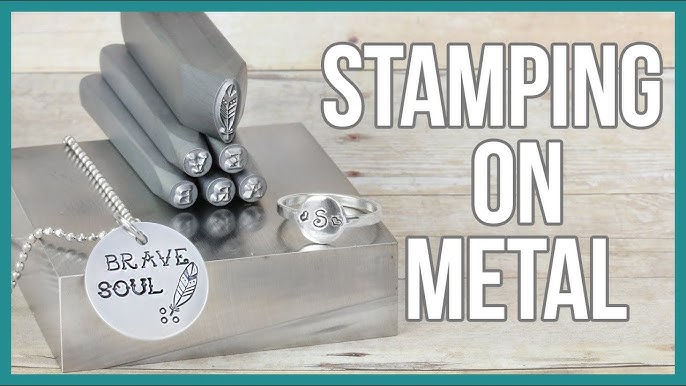Steel Marking Developments: Elevating Production Processes for Superior Results
In the world of manufacturing procedures, steel stamping has long been a keystone strategy for generating a range of precision components. With the relentless march of technological improvement, the landscape of steel stamping is going through a substantial improvement.
Development of Metal Marking Strategies

In addition, improvements in material scientific research have actually resulted in the development of high-strength alloys that can now be flawlessly marked into detailed forms, satisfying a broader series of commercial applications. The integration of robotics and fabricated knowledge has better optimized the stamping process by boosting speed and precision while decreasing the risk of human mistake.

Effect of Advanced Materials
Have sophisticated products transformed metal marking procedures considerably in the production industry? The solution is a definite yes (Metal Stamping). The combination of innovative products has changed metal marking, allowing producers to achieve greater precision, raised efficiency, and improved item top quality. By utilizing products such as high-strength alloys, progressed compounds, and innovative coatings, metal marking procedures can now create elements that are lighter, stronger, and more sturdy than ever.
These advanced products provide superior mechanical residential or commercial properties, corrosion resistance, and thermal stability, allowing makers to meet the demands of modern industries such as aerospace, automotive, and electronic devices. In addition, using sophisticated products in steel stamping has actually facilitated the production of complicated geometries and complex layouts that were previously unattainable with standard methods.
Moreover, the implementation of advanced materials has resulted in decreased product waste, lower production expenses, and shorter lead times, making steel stamping procedures more affordable and sustainable. As modern technology remains to advance, the effect of sophisticated products on steel stamping processes is expected to drive further innovation and boost the competitiveness of makers in the global market.
Automation in Metal Stamping
The development of steel stamping procedures driven by the integration of sophisticated materials has actually established the phase for substantial developments in automation within the manufacturing industry. Automation in metal marking has revolutionized production procedures, improving performance, accuracy, and overall outcome top quality. Via the usage of robotics, sensing units, and computer-controlled systems, jobs that were once hand-operated and time-consuming can now be carried out with unequaled speed and precision.
Automation in steel stamping not just increases production prices yet additionally ensures consistency in the manufacturing process. By lessening human intervention, the danger of errors is substantially reduced, causing greater levels of product uniformity and dependability. Additionally, automation enables suppliers to undertake complex stamping pop over to this site jobs that would be unwise or challenging to accomplish by hand.
In addition, automation in steel stamping adds to a more secure working atmosphere by minimizing the demand for workers to engage in recurring or dangerous jobs - Metal Stamping. This shift in the direction of automation not just boosts efficiency but likewise leads the way for the future of production, where technology plays a main function in driving functional quality
Quality Control and Evaluation Solutions
With a concentrate on precision and integrity, quality assurance and examination systems play an important role in guaranteeing item excellence in steel marking procedures. These systems are developed to monitor every phase of manufacturing, from material assessment to the end product, to guarantee that all elements meet the needed requirements. By carrying out sophisticated innovations such as optical examination systems, coordinate gauging devices (CMM), and automated gauging devices, manufacturers can detect also the tiniest deviations in measurements, surface top quality, and general honesty of stamped components.

Sustainability Practices in Steel Stamping
Structure upon the foundation of precision and reliability established with quality assurance and evaluation systems, the combination of lasting practices in steel marking processes is progressively coming to be a centerpiece for makers seeking to minimize ecological impact and maximize source utilization. Sustainability methods in metal marking encompass a range of efforts focused on lowering waste generation, power usage, and greenhouse gas emissions image source throughout the production procedure.
One key aspect of sustainability in metal stamping is the adoption of environment-friendly materials and technologies that advertise recyclability and waste reduction. By using recycled products and executing energy-efficient machinery, makers can reduce their carbon impact and contribute to a more sustainable production cycle. Furthermore, optimizing production processes to minimize product waste and power use not only profits the atmosphere yet likewise results in cost financial savings for companies in the future.
Additionally, the execution of sustainable techniques in steel marking can improve brand reputation and attract environmentally mindful consumers. As sustainability remains to acquire relevance in the manufacturing market, incorporating green campaigns into steel marking processes is crucial for long-term success and competition on the market.
Final Thought
Finally, steel marking strategies have significantly developed over time, incorporating innovative products and automation to improve producing processes. Quality assurance and inspection systems play a crucial role in making certain superior results, while sustainability methods are significantly being applied to lower environmental impact. These innovations in steel stamping have actually transformed the sector, leading to much more effective and sustainable manufacturing approaches for various industries.
Steel marking, as soon as a guidebook and labor-intensive procedure, has actually transformed right into a highly automated and sophisticated approach of forming steel sheets into different types and styles.Have sophisticated materials transformed steel stamping processes dramatically in the production market? By using materials such as high-strength alloys, advanced compounds, and innovative layers, steel stamping processes can now create elements that are lighter, stronger, and extra long lasting than ever in the past.
The advancement of metal stamping procedures driven by the combination of sophisticated materials has actually established the stage for significant advancements in automation within the production sector.In verdict, metal stamping strategies have internet considerably evolved over time, including innovative products and automation to improve making procedures.